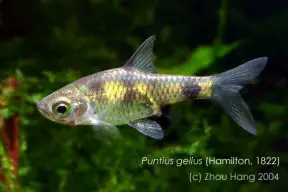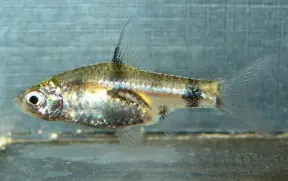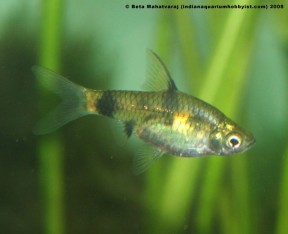Pethia aurea
Etymology
Pethia: the generic vernacular name for small cyprinids in the Sinhala language.
aurea: from the Latin aurea, meaning ‘golden’, in reference to the species’ colour.
Classification
Order: Cypriniformes Family: Cyprinidae
Distribution
Currently known only from a series of ponds in South 24 Parganas District, West Bengal state, northern India, in the Ganges River delta regin.
Type locality is ‘Ponds in South 24 – Parganas district, West Bengal’.
Maximum Standard Length
20 – 25 mm.
Aquarium SizeTop ↑
Base dimensions of at least 45 ∗ 30 cm or equivalent are required.
Maintenance
Best maintained in a planted aquarium and is an excellent choice for the carefully-aquascaped set-up.
The addition of some floating plants and driftwood roots or branches to diffuse the light entering the tank also seems to be appreciated and adds a more natural feel.
Filtration does not need to be particularly strong as it is likely to hail from sluggish waters and may struggle if there is a fast current.
Do not add this fish to a biologically immature set-up as it can be susceptible to swings in water chemistry.
Water Conditions
Temperature: 18 – 24 °C
pH: 6.0 – 7.0
Hardness: 18 – 179 ppm
Diet
Presumably a micropredator feeding on small insects, worms, crustaceans and other zooplankton in nature.
In the aquarium it will accept dried foods of a suitable size but should not be fed these exclusively.
Daily meals of small live and frozen fare such as Daphnia, Artemia, etc., along with good quality flakes and granules will result in the best colouration and encourage the fish to come into breeding condition.
Behaviour and CompatibilityTop ↑
Very peaceful but does not make an ideal community fish due to its small size and rather timid nature.
It will do best when maintained alone or with other diminutive species such as Microdevario, Trigonostigma, smaller Danio, Lepidocephalichthys, and freshwater shrimp of the genera Caridina and Neocaridina.
It’s a schooling species by nature and really should be kept in a group of at least 8-10 specimens.
Maintaining it in decent numbers will not only make the fish less nervous but will result in a more effective, natural-looking display, plus males will also display their best colours and some interesting behaviour as they compete with one other for female attention.
Sexual Dimorphism
Mature females are noticeably rounder-bellied, often a little larger and less-intensively coloured than males.
Reproduction
Like most small cyprinids Pethia spp. are egg-scattering free spawners exhibiting no parental care.
When in good condition they will spawn often and in a mature aquarium it’s possible that small numbers of fry may start to appear without intervention.
However if you want to maximise yield a more controlled approach is required.
The adult group can still be conditioned together but a smaller aquarium should also be set up and filled with mature water.
This should be very dimly lit and the base covered with some kind of mesh of a large enough grade so that the eggs can fall through but small enough so that the adults cannot reach them. The widely available plastic ‘grass’-type matting can also be used and works well, as does a layer of glass marbles.
Alternatively filling much of the tank with a fine-leaved plant such as Taxiphyllum spp. or spawning mops can also return decent results.
The water itself should be of slightly acidic to neutral pH with a temperature towards the upper end of the range suggested above, and an air-powered sponge filter or air stone(s) should also be included to provide oxygenation and water movement.
When the adults are well-conditioned and the females appear gravid one or two pairs should then be introduced, and spawning should take place the following morning.
An alternative is to spawn the fish in a group with half a dozen specimens of each sex being a good number, although a larger aquarium may be necessary.
In either situation the adults will probably eat the eggs given the chance and should be removed as soon as any are noticed.
These should hatch in 24-36 hours with the fry free swimming after 3-4 days.
They should be fed on an infusoria-grade food for the first few days until large enough to accept microworm, Artemia nauplii, or suchlike.
NotesTop ↑
This species was considered to be a phenotype of the similar-looking P. gelius prior to its description.
Following Knight (2013) it is included a group of closely-related species alongside P. gelius and P. canius, the trio being distinguished from other members of the genus Pethia by the following combination of characters: lateral line incomplete with 3-4 pored scales; 20-26 scales in lateral series; ½4/1/2 scales in transverse line on body; 8-9 predorsal scales; barbels absent; colour pattern comprising 2-3 black blotches on the body in life (fading in preserved specimens), the first behind the opercle, second beneath the dorsal-fin origin and extending to midbody, and third above the anal-fin origin, plus a black spot at the base of the dorsal and anal fins.
In addition P. aurea is distinguished from all other Pethia species by the following combination: lateral line incomplete with 3-4 pored scales; 25–26+1 scales in lateral series, ½5/1/3–3½ scales in transverse line on body; 9 predorsal scales; last unbranched dorsal-fin ray slender and serrated, with 19-22 serrae on posterior margin; barbels absent; a broad black band around the caudal peduncle covering scales 23-25 in the longitudinal series; a black blotch beneath the origin of the dorsal fin and a black spot above the origin of the anal fin.
In live specimens the body is yellowish-golden in colour, the dorsal-fin back with a pale yellow base and all other fins hyaline, whereas in P. canius the body is reddish in colour, the dorsal and caudal fins red, and anal-fin yellowish-orange, and in P. gelius the body is pale yellow and the dorsal, pelvic and anal fins bright yellow.
The genus Pethia was raised by Pethiyagoda et al. (2012) to accommodate a large group of species formerly included in the genus Puntius.
Members are defined by the following combination of characters: rostral barbels absent; maxillary barbels minute or absent; possession of a stiff, serrated last unbranched dorsal-fin ray; presence of a black blotch on the caudal peduncle, and frequently, black blotches, spots or bars on the side of the body; infraorbital 3 deep and partially overlapping the preoperculum.
Puntius was viewed as a polyphyletic catch-all containing over 100 species of small to mid-sized cyprinid for a number of years until Pethiyagoda et al. (2012) published a partial review covering South Asian members.
The majority of sub-Himalayan Puntius species were reclassified and new genera Dawkinsia, Dravidia, and Pethia erected to accomodate some of them, with the remainder either retained in Puntius or moved to the existing Systomus assemblage, though the definition of the latter was altered meaning some Southeast Asian species formerly placed there are no longer members.
It subsequently became clear that the name Dravidia was preoccupied by a genus of flesh fly, therefore the replacement name Haludaria was made available by Pethiyagoda (2013).
No species from Indochina, China, or Indonesia were included in the study meaning a significant number of former Puntius are currently classed as incertae sedis, i.e., of uncertain taxonomic placement, and this also applies to a number of South Asian species of unresolved status.
They’re perhaps best referred to as ‘Puntius‘ for the time being whereby the genus name is surrounded by quotation marks to denote its questionable usage, and that is the convention used here on SF at the moment.
References
- Knight, J. D. M., 2013 - Zootaxa 3700(1): 173-184
Pethia aurea (Teleostei: Cyprinidae), a new species of barb from West Bengal, India, with redescription of P. gelius and P. canius. - Knight, J. D. M., 2010 - Journal of Threatened Taxa 2(3): 786-787
Note: On a record of Puntius gelius (Hamilton, 1822) (Teleostei: Cypriniformes: Cyprinidae) from Tamil Nadu. - Pethiyagoda, R., 2013 - Zootaxa 3646(2): 199
Haludaria, a replacement generic name for Dravidia (Teleostei: Cyprinidae). - Pethiyagoda, R., M. Meegaskumbura, and K. Maduwage, 2012 - Ichthyological Exploration of Freshwaters 23(1): 69-95
A synopsis of the South Asian fishes referred to Puntius (Pisces: Cyprinidae).




